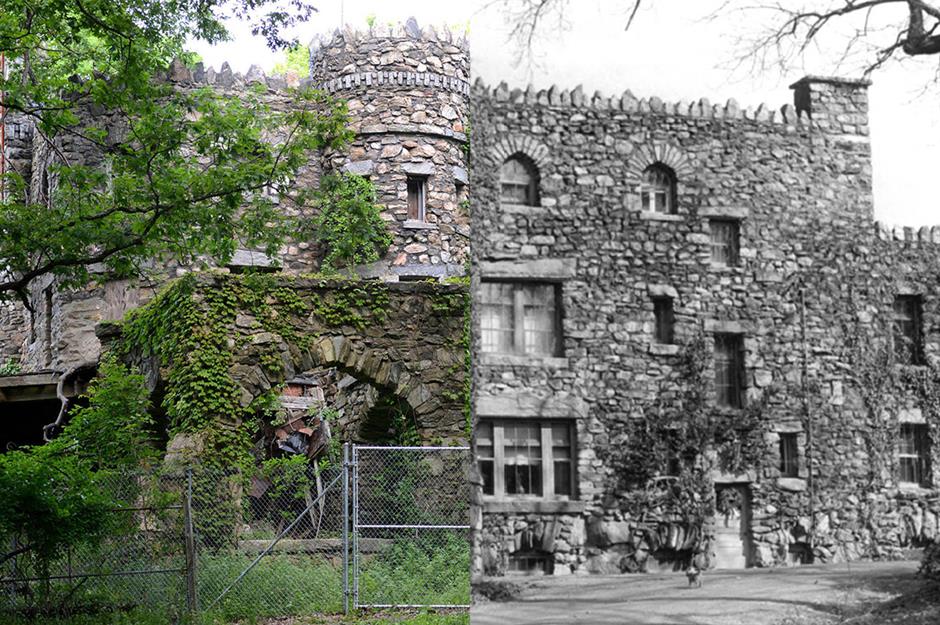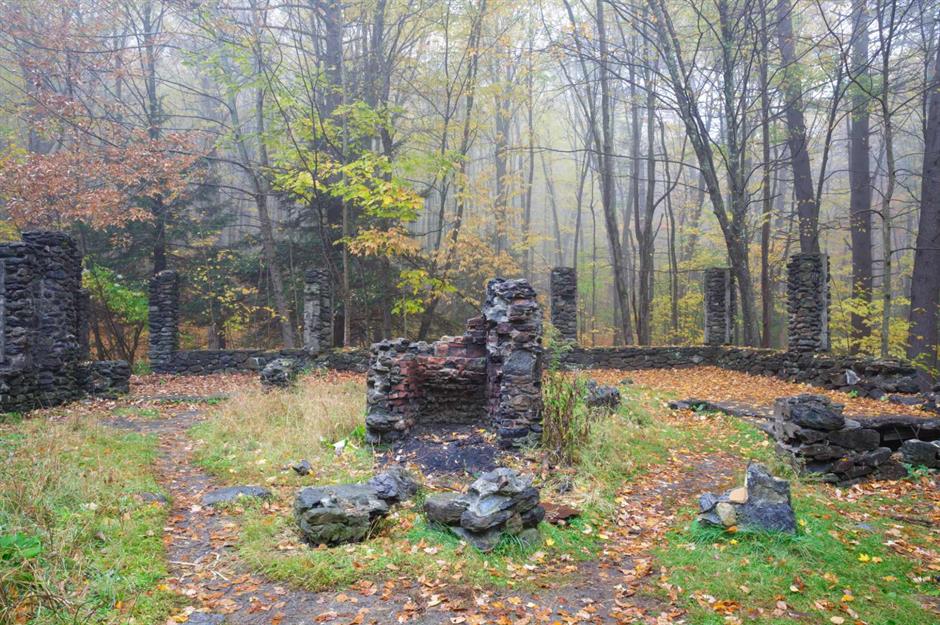America’s eerie abandoned castles
Spooky ruins
America has its fair share of abandoned, from a European-inspired mansion that was left unfinished to an eerie Scottish-style fortress that was partly destroyed by fire,
Click through the gallery to discover the best of these crumbling ruins and the history – and ghost stories – they hold…
Madame Sherri's Castle, Chesterfield, New Hampshire
There's very little left of Madame Sherri's Castle. Originally built in the 1920s by its namesake, an eccentric and wealthy costume designer, the mansion was created for the sole purpose of housing her legendary parties.
Sherri, whose real name was Antoinette Bramare, never actually lived in the 'castle', though – she resided in a comparatively modest house nearby, keeping her lavish digs for soirées.
Madame Sherri's Castle, Chesterfield, New Hampshire
By the 1950s and 1960s, Madame Sherri's wealth had begun to dwindle and the glamorous parties became a thing of the past. A fire in 1962 hastened the castle’s demise and Sherri, who passed away just three years later, didn’t have the funds to restore it to its former glory.
Today, little is left of the building, although its staircase, which is said to be haunted by its former proprietor’s ghost, is eerily well-preserved.
Scotty’s Castle, Death Valley, California
This Spanish Colonial Revival-style castle is another intriguing relic from the Roaring Twenties. It was built using the funds of millionaire Albert Mussey Johnson, as a holiday home for himself and his wife.
However, his unlikely friend and notorious conman Walter E. Scott, who had convinced Johnson to invest his money in a fraudulent mine in the area, took credit for its creation.
Scotty’s Castle, Death Valley, California
In its prime, the castle was a magnificent structure – all terracotta roofs, winding staircases, elegant arches and intricate ironwork. Yet the castle was never actually completed. In the 1930s, Johnson discovered that he’d accidentally been building on federal land and after the Great Depression, funds dried up.
Today, the historic building is protected as part of Death Valley National Park. It is currently closed for restoration after being damaged by flooding in 2015 and can only be visited as part of a ticketed tour.
Love this? Follow us on Facebook for more abandoned and spooky places
Coronado Heights Castle, Lindsborg, Kansas
Found on one of seven bluffs in Kansas’ Smoky Hills, Coronado Heights Castle was built less than a century ago, although its history goes back much further. In the 1540s, Spanish explorer Francisco Vasquez de Coronado visited this region in his hunt for the Seven Cities of Gold which, according to legend, were sites of extensive wealth.
The hilltop where the castle now stands is thought to have been Coronado’s final stop on his fruitless expedition.
Coronado Heights Castle, Lindsborg, Kansas
The castle was built during the Great Depression by the federal government-sponsored Works Progress Administration (WPA). Created in honour of the Spanish explorer, it contains a single large room (pictured) and has a rooftop which can be accessed via a staircase.
Nowadays, the creepy structure stands as an intriguing reminder of Coronado’s ill-fated quest.
Ha Ha Tonka Castle, Camdenton, Missouri
The enchanting ruins of Ha Ha Tonka Castle can be found on a towering bluff in the heart of the namesake state park, overlooking the Lake of the Ozarks. The idea for the castle was dreamed up by businessman Robert Snyder, who was inspired by the fairy-tale fortresses of Europe.
Building works began in 1905 but ground to a halt just a year later due to Snyder’s untimely death. Sadly, he was never able to see Ha Ha Tonka Castle in all its glory.
Ha Ha Tonka Castle, Camdenton, Missouri
Snyder's sons honoured their father's vision and the castle was completed by the 1920s. After that, it served as a private residence and also as a hotel. But in 1942, a fierce fire gutted the property and it has remained abandoned ever since.
If you’re looking for spooks, you can explore the ghostly structure on a hike, as it’s protected as part of Ha Ha Tonka State Park.
Wyndclyffe Mansion, Rhinebeck, New York
New York socialite Elizabeth Schermerhorn Jones, the aunt of novelist Edith Wharton, commissioned this stirring Gothic-style castle. Situated along the Hudson River near Rhinebeck, the property was built in the 1850s and it was so grand it inspired a whole host of other wealthy New Yorkers to build similar, castle-style homes of their own.
It’s even thought that the castle inspired the phrase 'keeping up with the Joneses'.
Wyndclyffe Mansion, Rhinebeck, New York
In its heyday it was an impressive affair with 24 rooms, magnificent arched windows, a three-floor atrium and a towering steeple. Edith Wharton came to visit her aunt here during summers but, according to her autobiography, she found it a terrifying and imposing place to be. After being handed to new owners following Jones’ death in 1876, the mansion was eventually abandoned in the 1950s.
Today, the once-imposing property continues to decay, although it was sold at auction in 2016 so it could see a revival yet.
Castle Mont Rouge, Rougemont, North Carolina
Looking at the ornate minarets and sharp spires of Castle Mont Rouge, it’s not surprising to learn that it was created by a sculptor. The castle, which is tucked away in a forest around 20 miles (32km) north of Durham, North Carolina, was built by local artist Robert Mihaly, with building works beginning in 2000.
Intended to serve as a studio and part-time home, the epic building is complete with turrets, gargoyles, copper cupolas and minarets.
Castle Mont Rouge, Rougemont, North Carolina
While it may look impressive from the outside, its interiors are unfinished. After Mihaly separated from his wife, he halted construction work, leaving its wooden floors to rot and its walls to become canvases for local graffiti artists.
Yet the castle could be set for a revival, as Mihaly has recently resumed building work and hopes to transform it into an event space and vineyard.
Atalaya Castle, Myrtle Beach, South Carolina
This unusual-looking castle was once a grand Moorish and Spanish-style mansion, used as the winter home of scholar and philanthropist Archer Huntington. Huntington built the residence between 1931 and 1933 in South Carolina's Murrells Inlet, after his wife, sculptor Anna Hyatt Huntington, was diagnosed with tuberculosis.
It was thought that the mild weather here would help improve Anna's health.
Atalaya Castle, Myrtle Beach, South Carolina
The castle had 30 sumptuous rooms, gardens filled with native plants and even zoo-like enclosures where the couple kept monkeys, bears and a leopard. Sadly, Archer Huntington died in 1955 and after that, Anna only visited the house a handful of times before abandoning it completely.
The site has been protected by the state since the 1960s and now visitors can head to Huntington Beach State Park to tour the deserted mansion.
Dundas Castle, Roscoe, New York
Ominously nicknamed the Castle of Sorrow, this abandoned Neo-Gothic pile can be found deep in New York's Catskill Mountains. It was commissioned by wealthy New Yorker Ralph Wurts-Dundas in the late 1910s, but he died in 1921 before its scheduled completion.
After his widow Josephine was sent to an asylum, the half-finished property passed to the couple's daughter Muriel, who was also left a large fortune to complete the building works.
Dundas Castle, Roscoe, New York
However, Muriel was allegedly swindled out of the money by the castle’s caretakers, so construction on the property had to halt yet again in 1924. Sadly, Muriel was also committed to an asylum and Dundas Castle was bought by a group of freemasons, who used it as a retreat and holiday camp.
Since the 1970s, it has laid empty – except, apparently, for the ghost of Josephine Wurts-Dundas who is said to haunt the property. Local lore also says that water in the ponds on the estate turns into blood during a full moon.
Hearthstone Castle, Danbury, Connecticut
The formerly grandiose Hearthstone Castle has passed through several hands during its history which spans more than 120 years. Built in the 1890s by New York photographer E. Starr Sanford, the structure, then known as Sanford Castle, was intended as a summer home for his family. With 16 rooms inside the fortress built from local stone, it would certainly have made a luxurious retreat.
Yet the photographer didn’t enjoy it for long, choosing to sell it in 1902 to wealthy industrialist Victor Buck.
Hearthstone Castle, Danbury, Connecticut
Buck renamed it (you guessed it) Buck’s Castle and held onto it for 16 years before selling it to another wealthy businessman: Charles Darling Parks. It was then that it gained its current name, which was supposedly a reference to the property’s many fireplaces.
The Parks family was its longest-lasting proprietors, holding onto Hearthstone Castle for some 70 years. Finally, it was purchased by the city of Danbury in 1985. In the years since, it has endured significant vandalism and decay.
Van Slyke Castle, Oakland, New Jersey
Hidden in the verdant depths of Ramapo Mountain State Forest, this early-1900s relic was once an impressive mansion. Originally named Foxcroft, it was built by stockbroker William Porter who envisaged it as his dream home. But his untimely death in 1911 meant the castle was left to his widow, Ruth, who married a lawyer – and the castle’s new namesake – Warren Van Slyke, a couple of years later.
It served as the couple’s vacation home before becoming Ruth’s permanent residence from the mid-1920s.
Van Slyke Castle, Oakland, New Jersey
After Ruth’s death in 1940, Van Slyke Castle passed through more owners, but was ultimately left to rot by the 1950s. A fire, lit by vandals in 1959, caused much of the remaining building to tumble to the ground.
Today, the ghostly ruins are gradually becoming consumed by the surrounding forest, making it a popular spot for curious hikers and explorers in the area.
Sauer Castle, Kansas City, Kansas
Abandoned castles don’t get much more creepy than this. Occupying a stately perch above the Kaw River valley, this Italianate-style, red-brick mansion was built in the 1870s by German-born businessman Anton Philip Sauer.
For several years, the four-storey property served as his elaborate family home, complete with sweeping staircases and an enormous greenhouse containing plants from all over Europe.
Sauer Castle, Kansas City, Kansas
But the family was plagued by tragedy. Sauer’s one-year-old daughter died in 1879, then just a month later Sauer died from tuberculosis. The property remained in the family’s hands for five generations, serving a brief stint under new owners in the 1950s before being purchased by Sauer’s great-great-grandson.
The former home is on private land so curious visitors must stay well back from the estate’s eerie gates.
Bannerman Castle, Pollepel Island, New York
Eccentric Scottish businessman Francis Bannerman VI was the brains behind this (equally eccentric) castle. Located on Pollepel Island, a tiny and uninhabited speck of land in the Hudson River around two hours north of New York City, it was built in the early 1900s.
Bannerman, who made his fortune from selling military equipment, wanted to create the Scottish-inspired fortress to house his extensive weapons and munitions collection.
Bannerman Castle, Pollepel Island, New York
However, such was Bannerman's ambition that the project was never truly finished. He died in 1918 and the decades that followed were tumultuous to say the least. After explosions, fires and the sinking of the ferryboat that serviced Pollepel Island, the odds seemed to be stacked against Bannerman Castle.
It was ultimately left to rot. Today, the site is frequented by tourists who come by boat and kayak to peer at the overgrown ruins.
Read on to discover the spectacular American castles you never knew existed

